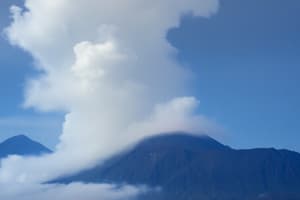Podcast
Questions and Answers
What is the primary characteristic that distinguishes shield volcanoes?
What is the primary characteristic that distinguishes shield volcanoes?
- Loose, fragmented cinders
- Explosive eruptions
- Steep, symmetrical sides
- Broad, gently sloping sides (correct)
Which type of volcano is known for its steep, nearly symmetrical sides and summit craters?
Which type of volcano is known for its steep, nearly symmetrical sides and summit craters?
- Composite volcanoes (correct)
- Lava dome volcanoes
- Shield volcanoes
- Cinder cone volcanoes
What is the primary composition of cinder cone volcanoes?
What is the primary composition of cinder cone volcanoes?
- Loose fragments called cinders, scoria, or spatter (correct)
- Layers of ash, pumice, and lava
- Thick, viscous lava
- Fluid basaltic lava
Which type of volcano often has explosive eruptions?
Which type of volcano often has explosive eruptions?
What is another name for composite volcanoes?
What is another name for composite volcanoes?
Which of the following is NOT one of the four main types of volcanoes mentioned in the text?
Which of the following is NOT one of the four main types of volcanoes mentioned in the text?
Which type of volcano is known for its rounded, bulbous extrusions of solidified lava?
Which type of volcano is known for its rounded, bulbous extrusions of solidified lava?
What is the most famous stratovolcano that is considered a symbol of Japan?
What is the most famous stratovolcano that is considered a symbol of Japan?
Which type of volcano is created when highly viscous lava explodes into cinders upon encountering air?
Which type of volcano is created when highly viscous lava explodes into cinders upon encountering air?
Which volcano formed a lava dome after a powerful eruption in 1915 and had a more recent eruption in 2021?
Which volcano formed a lava dome after a powerful eruption in 1915 and had a more recent eruption in 2021?
Which volcanic form is characterized by steep, symmetrical sides and a summit crater?
Which volcanic form is characterized by steep, symmetrical sides and a summit crater?
Where did the Paricutín volcano form in 1943 and grow to over 1,300 feet before becoming dormant in 1952?
Where did the Paricutín volcano form in 1943 and grow to over 1,300 feet before becoming dormant in 1952?
Flashcards are hidden until you start studying
Study Notes
Volcanoes
Volcanoes are geological formations where magma from beneath the Earth's crust erupts, forming vents or fissures in the ground. They come in various shapes and sizes, with four main types:
- Shield volcanoes
- Composite volcanoes
- Cinder cone volcanoes
- Lava dome volcanoes
- Stratovolcanoes
Shield Volcanoes
Shield volcanoes are large, broad volcanic cones formed by repeated flows of fluid lava. Their name is derived from their resemblance to ancient warrior shields. These volcanoes commonly appear in groups and form island chains such as Hawaii and Iceland. Their slopes tend to have low angles, typically between 5° and 15°. Fluid basaltic lava creates these gently sloping features. Examples of shield volcanoes include Mauna Loa and Kilauea in Hawaii.
Composite Volcanoes
Composite volcanoes, also known as stratovolcanoes, are characterized by their steep, nearly symmetrical sides and summit craters. They typically occur along tectonic plate boundaries and are built up through layers of alternating ash, pumice, and lava. These volcanoes can grow very tall, like Mount Fuji, and often have explosive eruptions. Examples of composite volcanoes include Mount Pinatubo in the Philippines and Mount St. Helens in Washington State, USA.
Cinder Cone Volcanoes
Cinder cone volcanoes are small, conical structures made primarily of loose fragments called cinders, scoria, or spatter produced during eruptive activity. These cones usually develop near shield volcanoes and are created when highly viscous lava explodes into cinders upon encountering air. One well-known example is Paricutín in Mexico, which formed in 1943 and grew to over 1,300 feet before becoming dormant in 1952. Other examples include the Painted Desert in New Mexico and Arizona, and the High Deserts of Oregon and California.
Lava Dome Volcanoes
Lava domes are rounded, bulbous extrusions of solidified lava that build around a volcano's central vent or a fracture in the volcano's side. Dome-building lava is generally thick and sticky, creating a dome that grows upwards and can eventually collapse under its own weight. Lava dome eruptions are often less explosive than those of other volcanic forms, but they can still be dangerous. An example of a lava dome volcano is Lassen Peak in California, which has had numerous eruptions since 1914, including a powerful 1915 eruption that formed a lava dome, and a more recent eruption in 2021 that created a small lava dome. Another example is Mount Merapi in Indonesia, which has been known to produce lava domes and explosive eruptions since the 16th century.
Stratovolcanoes
Stratovolcanoes, also known as composite volcanoes, have steep, symmetrical sides and a summit crater. They are built by repeated eruptions of thick, sticky lava and ash that accumulate to form a steep-sided cone. The most famous stratovolcano is Mount Fuji in Japan, which is one of the most well-known symbols of Japan. Other examples of stratovolcanoes include Mount Pinatubo in the Philippines, Mount St. Helens in Washington State, USA, and Mount Rainier in Washington State, USA. Eruptions of stratovolcanoes can be explosive, producing ash and debris, and they can also produce lava flows.
Studying That Suits You
Use AI to generate personalized quizzes and flashcards to suit your learning preferences.




